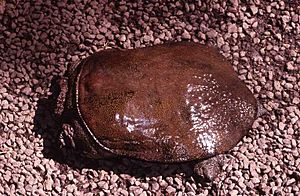Wattle-necked softshell turtle facts for kids
Quick facts for kids Wattle-necked softshell turtle |
|
|---|---|
 |
|
| Conservation status | |
| Scientific classification | |
| Genus: |
Palea
|
| Species: |
steindachneri
|
| Synonyms | |
|
|
The wattle-necked softshell turtle (Palea steindachneri), also known as Steindachner's soft-shelled turtle, is an endangered Asian species of softshell turtle. This unique turtle is the only member of its genus called Palea.
Contents
About the Wattle-Necked Softshell Turtle
These turtles are known for their soft, leathery shells, which are different from the hard shells of many other turtles. They live in freshwater environments.
What Does This Turtle Look Like?
Wattle-necked softshell turtles show something called sexual dimorphism. This means that males and females look a bit different from each other.
- Female turtles can grow up to 44.5 centimeters (about 17.5 inches) long when measured along their shell.
- Male turtles are smaller, reaching only about 36 centimeters (around 14 inches) in shell length.
- Even though males are smaller, they have a longer tail than the females.
Where Does Its Name Come From?
The scientific name for this turtle, steindachneri, was given to honor a famous Austrian scientist named Franz Steindachner. He was a herpetologist, which is a person who studies reptiles and amphibians.
Where Do These Turtles Live?
The wattle-necked softshell turtle is naturally found in several countries in Southeast Asia.
- They live in southeastern China, in areas like Guangdong, Guangxi, Guizhou, Hainan, and Yunnan.
- You can also find them in Laos and Vietnam.
These turtles have also been moved by people to new places, becoming introduced species. They can now be found in Hawaii and Mauritius.
Why Are These Turtles in Danger?
The wattle-necked softshell turtle is an endangered species. This means their numbers are getting very low in the wild.
- One big reason they are endangered is because they are hunted for food.
- Even though many are still hunted, there are also many turtles raised on special farms in China and Vietnam. These farms help to provide turtles for food and for use in traditional medicine.


